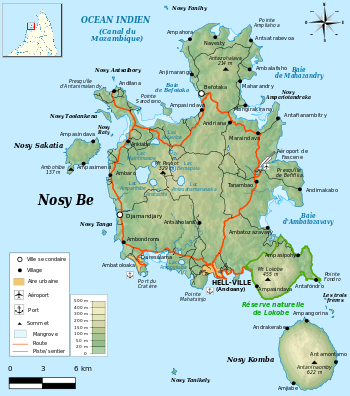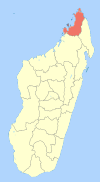Nosy Be


Nosy Be [ˌnusʲ ˈbe] (also Nossi-bé and Nosse Be) is an island off the northwest coast of Madagascar. Nosy Be is Madagascar's largest and busiest tourist resort. It has an area of 312 square kilometres (120 sq mi) and its population was officially estimated at 36,636 in 2001.
Nosy Be means "big island" in the Malagasy language. The island was called Assada during the early colonial era of the seventeenth century. Nosy Be has been given several nicknames over the centuries, including "Nosy Manitra" (the scented island).
History
The first of Nosy Be were small bands of Antankarana and Zafinofotsy, before the arrival the Sakalava represent the most numerous ethnic group on the island. These people were joined later by some Comorians, Indians or Antandroy.
Nosy Be made first major appearance in Madagascar's history when King Radama I announced that he intended to conquer the whole west of the red island up to the sea. That plan was eventually achieved when the Sakalava Kingdom of Boina came into his possession in 1837 when Queen Tsiomeko of Boina's army was defeated.
Geography
Nosy Be is located about eight kilometers (5.0 miles) (5 miles) from the coast of Madagascar in the Mozambique Channel; several smaller islands are located nearby, including Nosy Komba, Nosy Mitsio, Nosy Sakatia, and Nosy Tanikely. The island's main town is Andoany.
The volcanic island has an area of about 312 square kilometres (120 sq mi), and reaches its highest peak at Mont Lokobe at 450 metres (1,480 ft); the volcano is of Holocene origin but has not erupted in recorded history.[1] There are eleven volcanic crater lakes on the island.
The island is known for having one of the world's smallest frogs[2] (Stumpffia pygmaea) and chameleon (Brookesia minima).[3] The Lokobe Reserve is one of Madagascar's five Strict Nature Reserves (Réserves Naturelles Intégrales). Nosy Be is also home to a specific color of panther chameleon (Furcifer pardalis).
Nosy Be has a tropical climate. It is most humid in summer (December, January, February). The Tsaratanana massif partially protects the island from the strong north-east winds affecting the region in August or during tropical depressions.
Administration
The island constitutes a department within Diana Region and is organized as the City of Nosy Be (Commune urbaine). Its mayor is Mr. Jaovita.
Economy
Once a major location of plantation of sugar cane and production of its derived products ( sugar, rhum ), the island's main activities are now the plantation of Ylang Ylang ( for the production of essential oils ) and tourism. Nosy Be is the most developed tourism destination in Madagascar. This is the only place in Madagascar where all-inclusive large resorts can be found.
Transportation
The island is served by Fascene Airport. The airport has direct flights from Europe on Corsairfly, Air Madagascar and Air Italy. Its main city and harbour, Andoany (formerly known as Hellville), can be reached by boat from Ankify.
Twin towns — Sister cities
Nosy Be is twinned with:
See also
- List of volcanoes in Madagascar
- Tours
- Tours in Madagascar featuring Nosy Be
- Information about Nosy Be and Madagascar
References
- ↑ "Nosy-Be". Global Volcanism Program. Smithsonian Institution.
- ↑ Stumpffia pygmaea
- ↑ Tim Flannery and Peter Schouten, Astonishing Animals: Extraordinary Creatures and the Fantastic Worlds They Inhabit. New York: Atlantic Monthly Press, 2004. Page 126-127.
- ↑ Vacca, Maria Luisa. "Comune di Napoli -Gemellaggi" [Naples - Twin Towns]. Comune di Napoli (in Italian). Archived from the original on 2013-06-22. Retrieved 2013-08-08.
External links
| Wikimedia Commons has media related to Nosy Be. |
| Wikivoyage has a travel guide for Nosy Be. |
Coordinates: 13°20′S 48°15′E / 13.333°S 48.250°E
| ||||||||||||||||||||||||
